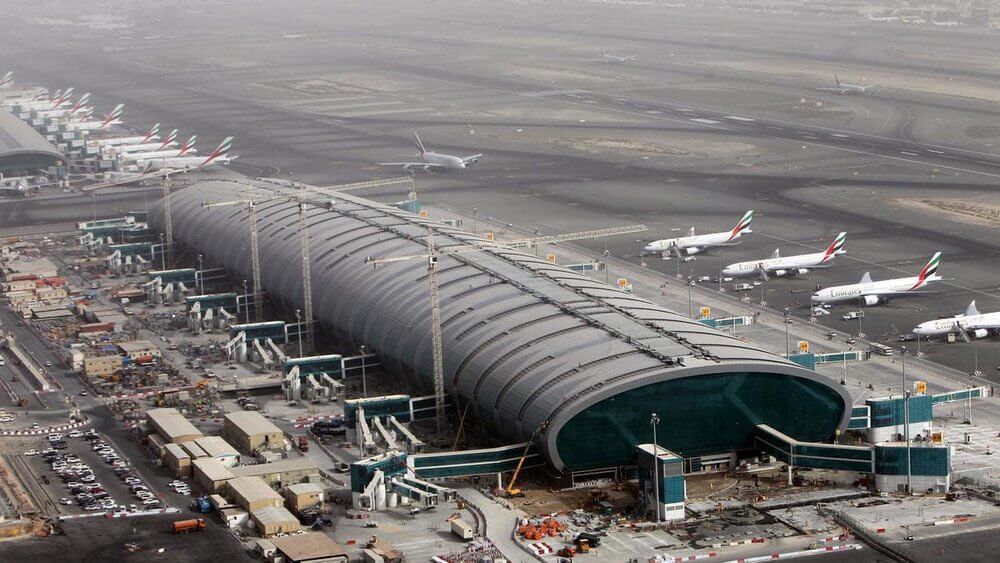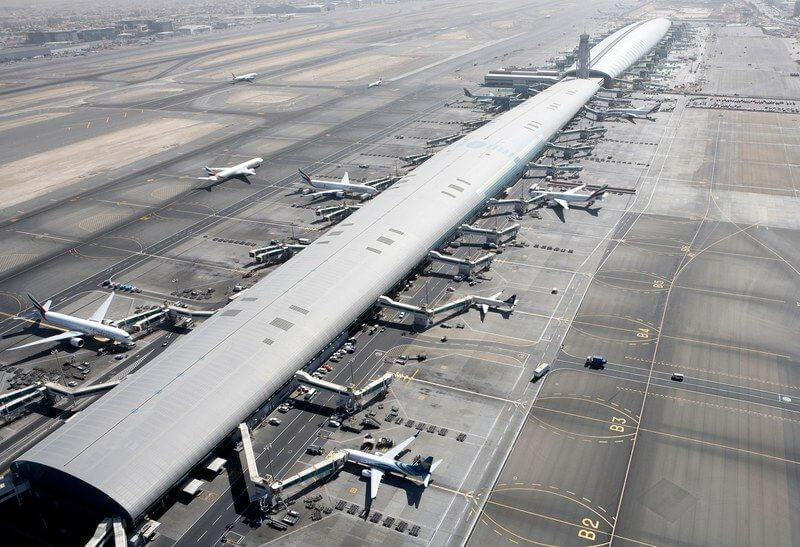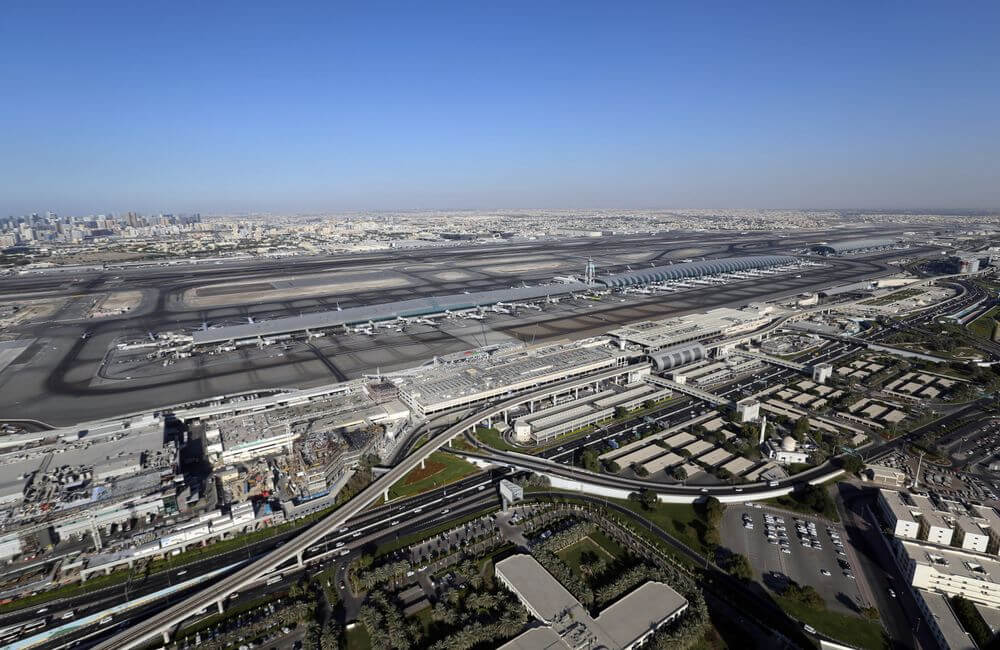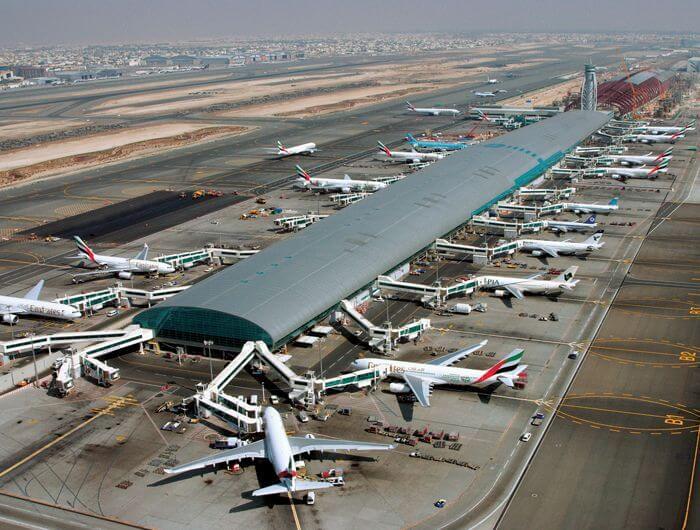Dubai International Airport (Arabic: مطاردبي الدولي) is located in Dubai, UAE, and is one of the busiest airports in the world. In 2017, DXB handled 88 million passengers and 2.65 million tons of cargo, and registered 409,493 aircraft movements.
Dubai International Airport is located in the Al Garhoud area 2.5 nautical miles (4.6 kilometers; 2.9 miles) east of Dubai, spread over 7,200 acres (2900 hectares) of land.
Terminal 3 is one of the largest airport terminals in the world. Other large individual terminals include the terminal of Beijing Daxing International Airport in China and the terminal of Istanbul Airport in Turkey.

Emirates has a hub airport in Dubai International (DXB) and has its own Terminal 3, of which there are 3 terminals, which are shared with flydubai. The Emirates hub is the largest airline hub in the Middle East.
The total annual capacity of the airport is 90 million passengers. As of January 2016, there are more than 140 airlines operating more than 7,700 weekly flights to more than 270 destinations on all continents. In 2018, more than 63% of passengers who used the airport were transit passengers.
Dubai International Group is an important contributor to the Dubai economy, with approximately 90,000 employees, indirectly supporting more than 400,000 jobs, contributing more than 26.7 billion US dollars to the economy, accounting for approximately 27% of Dubai’s GDP and 21% of Dubai’s employment.

History
- Dubai Airport was built in 1959. It opened with its first airport in 1960, when it had only a 1,800-meter (5,900-foot) runway made of compacted sand.
- In May 1963, construction of an asphalt runway measuring 9,200 feet (2800 m) began. By 1969, the airport had been served by 9 airlines serving 20 destinations.
- A new terminal, runway and taxiway were built in 1970 to cope with international flights. The newly built terminal includes a three-story 110 m (360 ft) tall building with an enclosed building area of 13,400 m 2 (144,000 square feet). A new 28 m (92 ft) control tower was also built.
- The second terminal was opened in 1998. The length of the hall is 0.8 km (0.50 mile) and is connected to the boarding area through a 0.3 km (0.19 mile) tunnel that contains a moving sidewalk (conveyor belt/wagon).
- The construction of Terminal 3 began in 2004 and is the next phase of the second phase of the project, with an estimated cost of approximately US$4.55 billion. On May 30, 2008, a capping ceremony was held.
- In 2009, Terminal 2 expanded its facilities to handle 5 million passengers per year (an increase of 2 million), bringing the total airport capacity to 62 million passengers.
- On October 29, 2010, the airport celebrated its 50th anniversary. The airport has received more than 402 million passengers, with an average annual growth rate of 15.5%, and handled more than 3.87 million aircraft, with an average annual growth rate of 12.4%.
- In September 2012, Dubai Airport changed the name of the terminal to make it easier for passengers to navigate the airport. Terminal 1 operated by more than 100 international airlines became Terminal C, Terminal 2 became Terminal B, and Terminal 3 became Terminal A.
- The boarding gate in Terminal 2 has been changed and is now numbered F1 to F6. The remaining alphanumeric sequences are reserved for future airport facilities, which are part of Dubai Airport’s $7.8 billion expansion plan, including Hall D.

Main building
Tower
The 87-meter-high (285-foot) Airport Traffic Control Tower (ATCT) was part of the second phase of the development plan at the time.
Terminal
There are three terminals at Dubai International Airport. Terminal 1 has a terminal building (Terminal D), Terminal 2 is separated from the other two main buildings, and Terminal 3 is divided into Terminals A, B, and C. The cargo terminal can handle 3 million tons of cargo each year, and the General Aviation Terminal (GAT) is nearby.
Before most of Emirates’ business was transferred to Hall B, the aircraft stopped in Hall C. In 2016, as all airlines operating from Hall C moved to Hall D, Emirates took over the operation of Hall C.
Passenger terminal
There are three passenger terminals at Dubai Airport. Terminals 1 and 3 are directly connected to the public transit area. Airside passengers can move freely between terminals without going through immigration procedures, while Terminal 2 is located opposite the airport.
The executive terminal is located next to Terminal 2. The terminal has its own boarding facilities that can provide services to senior passengers, while in other terminals, the planes are transported by individual children.
The total handling capacity of these three passenger terminals is approximately 80 million passengers per year.

Dubai International Airport Data
- Country
- United Arab Emirates
- Region
- Western Asia
- Status
- In use
- Official name
- مطار دبي الدولي
- Location
- Dubai, United Arab Emirates
- Owner
- Government of Dubai
- Official website
- dubaiairports.ae
- Operator
- Dubai Airports Company
- Began
- 1959
- Opened
- 1960
- Airport type
- Public
- Airport code
- IATA: DXBICAO: OMDBWMO: 41194
- Airport area
- 7166 acres / 29 km²
- Runway length
- 1*4,000 m,1*4,450 m
- Passenger traffic
- 86.39 million(2019)
- Freight volume
- 2,514,918 tons (2019)
- Takeoffs and landings
- 373,261 sorties
View Dubai International Airport on Google Satellite Map
Google satellite maps allow you to see building details more clearly, including natural landscapes such as mountains, rivers, deserts, sea and man-made engineering buildings.
If you are very interested in this engineering building, it is a good idea to click below Google Map icon. We will help you jump to the corresponding location of this building or engineering on Google satellite map.






























































